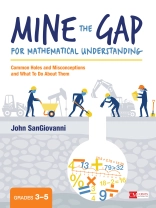Being an effective math educator is one part based on the quality of the tasks we give, one part how we diagnose what we see, and one part what we do with what we find. Yet with so many students and big concepts to cover, it can be hard to slow down enough to look for those moments when students’ responses tell us what we need to know about next best steps. In this remarkable book, John San Giovanni helps us value our students’ misconceptions and incomplete understandings as much as their correct ones—because it’s the gap in their understanding today that holds the secrets to planning tomorrow’s best teaching.
San Giovanni lays out 180 high-quality tasks aligned to the standards and big ideas of Grades 3-5 mathematics, including addition and subtraction of multi-digit whole numbers, multiplication and division of single and multi-digit whole numbers, foundational fraction concepts, foundational decimal concepts, and operations with fractions and decimals. The tasks are all downloadable so you can use or modify them for instruction and assessment. Each big idea offers a starting task followed by:
- what makes it a high-quality task
- what you might anticipate before students work with the task
- 4 student examples of the completed task showcasing a distinct 'gap’
- commentary on what precisely counts for mathematical understanding and the next instructional steps
- commentary on the misconception or incomplete understanding so you learn why the student veered off course
- three additional tasks aligned to the mathematics topic and ideas about what students might do with these additional tasks.
It’s time to break our habit of rushing into re-teaching for correctness and instead get curious about the space between right and wrong answers. Mine the Gap for Mathematical Understanding is a book you will return to again and again to get better at selecting tasks that will uncover students’ reasoning—better at discerning the quality and clarity of students’ understanding—and better at planning teaching based on the gaps you see.
Spis treści
Big Ideas & Tasks at a Glance
Acknowledgments
Publisher’s Acknowledgments
About the Author
Introduction
CHAPTER 1: RICH MATHEMATICS TASKS, STUDENT MISCONCEPTIONS, USING TASKS
CHAPTER 2: ADDITION AND SUBTRACTION WITHIN 1, 000
BIG IDEAS
1: Adding Within 1, 000
2: Reasoning About Addition Within 1, 000
3: Subtraction Within 1, 000
4: Reasoning About Subtraction Within 1, 000
5: Problem Solving With Addition and Subtraction
CHAPTER 3: MULTIPLICATION AND DIVISION
BIG IDEAS
6: Representing Multiplication
7: Reasoning About Multiplication
8: Properties of Multiplication
9: Representing Division
10: Reasoning About Division
11: Problem Solving With Multiplication and Division
12: Connecting Multiplication and Division
13: Representing Multi-Digit Multiplication
14: Reasoning About Multi-Digit Multiplication
15: Representing Multi-Digit Division
16: Reasoning About Multi-Digit Division
CHAPTER 4: FOUNDATIONAL FRACTION CONCEPTS
BIG IDEAS
17: Representing Fractions
18: Connecting Representations of Fractions
19: Fractions on a Number Line
20: Fractions Greater Than 1 on a Number Line
21: Decomposing Fractions
22: Equivalent Fractions on a Number Line
23: Comparing Fractions
24: Reasoning About Fractions
25: More Reasoning About Fractions
CHAPTER 5: DECIMAL CONCEPTS
BIG IDEAS
26: Representing Decimals
27: Representing Decimals as Numbers
28: Estimating and Rounding Decimals
29: Decomposing Decimals
30: Comparing Decimals
31: Addition With Decimals
32: Subtracting With Decimals
33: Problem Solving With Decimals
CHAPTER 6: ADDITION AND SUBTRACTION WITH FRACTIONS
BIG IDEAS
34: Addition With Fractions on Number Lines
35: Reasoning About Addition With Fractions
36: Subtraction With Fractions
37: Reasoning About Subtraction With Fractions
38: Problem Solving With Addition and Subtraction of Fractions
39: Addition and Subtraction With Mixed Numbers
CHAPTER 7: MULTIPLICATION AND DIVISION WITH FRACTIONS AND DECIMALS
BIG IDEAS
40: Multiplication of Fractions
41: More With Multiplication of Fractions
42: Division With Fractions
43: Problem Solving With Multiplication and Division of Fractions
44: Multiplication With Decimals
45: Division With Decimals
CHAPTER 8: WHAT DO WE DO NEXT?
References and Additional Resources
O autorze
John J. San Giovanni is a mathematics coordinator in Howard County, Maryland. There, he leads mathematics curriculum development, digital learning, assessment, and professional development. John is an adjunct professor and coordinator of the Elementary Mathematics Instructional Leadership graduate program at Mc Daniel College. In addition to this Figuring Out Fluency series, some of his many Corwin books include Daily Routines to Jump-Start Problem Solving, Grades K-8, Answers to Your Biggest Questions about Teaching Elementary Math, the Daily Routines to Jump-Start Math series, and Productive Math Struggle: A 6-Point Action Plan for Fostering Perseverance. John is a national mathematics curriculum and professional learning consultant who also speaks frequently at national conferences and institutes. He is active in state and national professional organizations, recently serving on the board of directors for the National Council of Teachers of Mathematics (NCTM) and currently on the board of directors for the National Council of Supervisors of Mathematics (NCSM).












